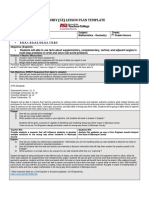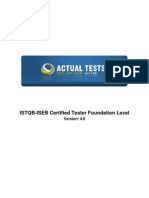Reading Comprehension 1
Reading Comprehension 1
Uploaded by
valentina sarastiCopyright:
Available Formats
Reading Comprehension 1
Reading Comprehension 1
Uploaded by
valentina sarastiOriginal Description:
Original Title
Copyright
Available Formats
Share this document
Did you find this document useful?
Is this content inappropriate?
Copyright:
Available Formats
Reading Comprehension 1
Reading Comprehension 1
Uploaded by
valentina sarastiCopyright:
Available Formats
READING COMPREHENSION
Multiple Choice
Identify the choice that best completes the statement or answers the question.
How Do You Train an Elephant?
Perhaps you have heard about elephants that can paint pictures or play musical instruments. They seem able
to learn how to do everything except speak. Have you ever thought about what methods trainers use to get
these huge animals to perform this way? Although elephants are very intelligent, they are still wild animals,
after all.
First of all, an elephant knows the difference between a kind person and a mean one. The best trainers are able
to imagine themselves in the elephant's place. They realize that the better they understand the animal, the
better teachers they will be. They are always gentle with the animals and prefer to encourage them to do
things instead of forcing them.
Some trainers use a system that involves giving the animal a treat, such as an apple, whenever it does what it
is asked to do. One advantage of this strategy is that it helps the elephant feel comfortable with its trainer.
When an elephant does something wrong, a good trainer thinks, "How would elephants treat each other in this
situation?" Sometimes the answer is to use force, but to use it properly and as gently as possible.
____ 1. What is the main topic of the passage?
a The advantages of training elephants
.
b A very intelligent elephant
.
c Why training elephants is dangerous
.
d How trainers teach elephants
.
____ 2. A good elephant trainer should ____.
a know how to paint
.
b force the animal to do its job
.
c be able to think like an elephant
.
d use music as part of the training
.
____ 3. The writer says that an elephant can't be taught to ____.
a paint
.
b speak
.
c follow directions
.
d play a musical instrument
.
____ 4. In paragraph 2, sentence 1, what does the word kind mean?
a young
.
b friendly
.
c poor
.
d slow
.
____ 5. Read the third sentence of paragraph 2. What does it mean?
a Elephants should try to understand their trainers.
.
b Most trainers do not understand elephants well.
.
c Trainers can only understand the best elephants.
.
d Trainers do a better job when they understand the elephants.
.
____ 6. What is the main idea of paragraph 3?
a Friendliness is a better way of training than using force.
.
b Trainers should use force whenever they have problems.
.
c Elephants have many problems understanding trainers.
.
d Giving treats to elephants doesn't always work.
.
____ 7. In paragraph 3, sentence 2, its refers to ____.
a the trainer's
.
b the elephant's
.
c an apple's
.
d a system's
.
True/False
Indicate whether the statement is true or false.
Refer to "How Do You Train an Elephant?" to answer the questions.
__F__ 8. The writer says that elephants can tell if a trainer is mean.
__T__ 9. Some trainers use treats to help train elephants.
__F__ 10. In paragraph 3, sentence 3, the phrase treat each other means give each other treats.
READING COMPREHENSION
Answer Section
MULTIPLE CHOICE
1. ANS: D PTS: 1 REF: p. 11 | p. 15 OBJ: Reading for Gist
2. ANS: C PTS: 1 REF: p. 11 | p. 15 OBJ: Reading for Detail
3. ANS: B PTS: 1 REF: p. 11 | p. 15 OBJ: Reading for Detail
4. ANS: B PTS: 1 REF: p. 11 | p. 15 OBJ: Vocabulary in Context
5. ANS: D PTS: 1 REF: p. 11 | p. 15 OBJ: Paraphrasing
6. ANS: A PTS: 1 REF: p. 11 | p. 15 OBJ: Understanding Main Ideas
7. ANS: B PTS: 1 REF: p. 11 | p. 15 OBJ: Understanding References
TRUE/FALSE
8. ANS: T PTS: 1 REF: p. 11 | p. 15 OBJ: Reading for Detail
9. ANS: T PTS: 1 REF: p. 11 | p. 15 OBJ: Reading for Detail
10. ANS: F PTS: 1 REF: p. 11 | p. 15 OBJ: Vocabulary in Context
You might also like
- The Subtle Art of Not Giving a F*ck: A Counterintuitive Approach to Living a Good LifeFrom EverandThe Subtle Art of Not Giving a F*ck: A Counterintuitive Approach to Living a Good Life4/5 (6054)
- The Gifts of Imperfection: Let Go of Who You Think You're Supposed to Be and Embrace Who You AreFrom EverandThe Gifts of Imperfection: Let Go of Who You Think You're Supposed to Be and Embrace Who You Are4/5 (1142)
- Never Split the Difference: Negotiating As If Your Life Depended On ItFrom EverandNever Split the Difference: Negotiating As If Your Life Depended On It4.5/5 (917)
- Hidden Figures: The American Dream and the Untold Story of the Black Women Mathematicians Who Helped Win the Space RaceFrom EverandHidden Figures: The American Dream and the Untold Story of the Black Women Mathematicians Who Helped Win the Space Race4/5 (946)
- The Hard Thing About Hard Things: Building a Business When There Are No Easy AnswersFrom EverandThe Hard Thing About Hard Things: Building a Business When There Are No Easy Answers4.5/5 (361)
- Devil in the Grove: Thurgood Marshall, the Groveland Boys, and the Dawn of a New AmericaFrom EverandDevil in the Grove: Thurgood Marshall, the Groveland Boys, and the Dawn of a New America4.5/5 (273)
- The World Is Flat 3.0: A Brief History of the Twenty-first CenturyFrom EverandThe World Is Flat 3.0: A Brief History of the Twenty-first Century3.5/5 (2283)
- A Heartbreaking Work Of Staggering Genius: A Memoir Based on a True StoryFrom EverandA Heartbreaking Work Of Staggering Genius: A Memoir Based on a True Story3.5/5 (233)
- 7.McLeod & Genereux, 2008 - Predicting The Acceptability and Likelihood of Lying - The Interaction of Personality and Type of Lies PDFNo ratings yet7.McLeod & Genereux, 2008 - Predicting The Acceptability and Likelihood of Lying - The Interaction of Personality and Type of Lies PDF6 pages
- Field Work No. 8 Determination of The Height of A Remote PointNo ratings yetField Work No. 8 Determination of The Height of A Remote Point10 pages
- HY-TA5DV Five Axis Actuation Board Instruction BookletNo ratings yetHY-TA5DV Five Axis Actuation Board Instruction Booklet8 pages
- Inquiry (5E) Lesson Plan Template: Evidence of Mastery (Measurable)No ratings yetInquiry (5E) Lesson Plan Template: Evidence of Mastery (Measurable)2 pages
- Accredited by NAAC With A' Grade, An ISO 9001:2015 Certified InstitutionNo ratings yetAccredited by NAAC With A' Grade, An ISO 9001:2015 Certified Institution167 pages
- Construction Overview: Varco Pruden BuildingsNo ratings yetConstruction Overview: Varco Pruden Buildings2 pages
- Lee, Yeon Soo Lee, Jun Young Park, Sang Soo Lim, Chae Won KW - A Comparison of Bicortical and IntramNo ratings yetLee, Yeon Soo Lee, Jun Young Park, Sang Soo Lim, Chae Won KW - A Comparison of Bicortical and Intram6 pages
- Preparation of MFR in Pharmaceutical Industry.100% (1)Preparation of MFR in Pharmaceutical Industry.4 pages
- Session Session Objectives Resources Materials Needed Persons Involved Mentoring Date Expected OutputNo ratings yetSession Session Objectives Resources Materials Needed Persons Involved Mentoring Date Expected Output9 pages
- Tutorial Replace Lenovo Y510P Cache Drive With MyDigitalSSD Super Cache 2 SSDNo ratings yetTutorial Replace Lenovo Y510P Cache Drive With MyDigitalSSD Super Cache 2 SSD14 pages
- Decimal Operations: Adding & Subtracting Multiplying DividingNo ratings yetDecimal Operations: Adding & Subtracting Multiplying Dividing1 page
- Column Addition and Subtraction Homework Year 4100% (1)Column Addition and Subtraction Homework Year 47 pages
- The Subtle Art of Not Giving a F*ck: A Counterintuitive Approach to Living a Good LifeFrom EverandThe Subtle Art of Not Giving a F*ck: A Counterintuitive Approach to Living a Good Life
- The Gifts of Imperfection: Let Go of Who You Think You're Supposed to Be and Embrace Who You AreFrom EverandThe Gifts of Imperfection: Let Go of Who You Think You're Supposed to Be and Embrace Who You Are
- Never Split the Difference: Negotiating As If Your Life Depended On ItFrom EverandNever Split the Difference: Negotiating As If Your Life Depended On It
- Hidden Figures: The American Dream and the Untold Story of the Black Women Mathematicians Who Helped Win the Space RaceFrom EverandHidden Figures: The American Dream and the Untold Story of the Black Women Mathematicians Who Helped Win the Space Race
- The Hard Thing About Hard Things: Building a Business When There Are No Easy AnswersFrom EverandThe Hard Thing About Hard Things: Building a Business When There Are No Easy Answers
- Elon Musk: Tesla, SpaceX, and the Quest for a Fantastic FutureFrom EverandElon Musk: Tesla, SpaceX, and the Quest for a Fantastic Future
- The Emperor of All Maladies: A Biography of CancerFrom EverandThe Emperor of All Maladies: A Biography of Cancer
- The Little Book of Hygge: Danish Secrets to Happy LivingFrom EverandThe Little Book of Hygge: Danish Secrets to Happy Living
- The Yellow House: A Memoir (2019 National Book Award Winner)From EverandThe Yellow House: A Memoir (2019 National Book Award Winner)
- Devil in the Grove: Thurgood Marshall, the Groveland Boys, and the Dawn of a New AmericaFrom EverandDevil in the Grove: Thurgood Marshall, the Groveland Boys, and the Dawn of a New America
- The World Is Flat 3.0: A Brief History of the Twenty-first CenturyFrom EverandThe World Is Flat 3.0: A Brief History of the Twenty-first Century
- The Sympathizer: A Novel (Pulitzer Prize for Fiction)From EverandThe Sympathizer: A Novel (Pulitzer Prize for Fiction)
- Team of Rivals: The Political Genius of Abraham LincolnFrom EverandTeam of Rivals: The Political Genius of Abraham Lincoln
- A Heartbreaking Work Of Staggering Genius: A Memoir Based on a True StoryFrom EverandA Heartbreaking Work Of Staggering Genius: A Memoir Based on a True Story
- On Fire: The (Burning) Case for a Green New DealFrom EverandOn Fire: The (Burning) Case for a Green New Deal
- The Unwinding: An Inner History of the New AmericaFrom EverandThe Unwinding: An Inner History of the New America
- 7.McLeod & Genereux, 2008 - Predicting The Acceptability and Likelihood of Lying - The Interaction of Personality and Type of Lies PDF7.McLeod & Genereux, 2008 - Predicting The Acceptability and Likelihood of Lying - The Interaction of Personality and Type of Lies PDF
- Field Work No. 8 Determination of The Height of A Remote PointField Work No. 8 Determination of The Height of A Remote Point
- HY-TA5DV Five Axis Actuation Board Instruction BookletHY-TA5DV Five Axis Actuation Board Instruction Booklet
- Inquiry (5E) Lesson Plan Template: Evidence of Mastery (Measurable)Inquiry (5E) Lesson Plan Template: Evidence of Mastery (Measurable)
- Accredited by NAAC With A' Grade, An ISO 9001:2015 Certified InstitutionAccredited by NAAC With A' Grade, An ISO 9001:2015 Certified Institution
- Lee, Yeon Soo Lee, Jun Young Park, Sang Soo Lim, Chae Won KW - A Comparison of Bicortical and IntramLee, Yeon Soo Lee, Jun Young Park, Sang Soo Lim, Chae Won KW - A Comparison of Bicortical and Intram
- Session Session Objectives Resources Materials Needed Persons Involved Mentoring Date Expected OutputSession Session Objectives Resources Materials Needed Persons Involved Mentoring Date Expected Output
- Tutorial Replace Lenovo Y510P Cache Drive With MyDigitalSSD Super Cache 2 SSDTutorial Replace Lenovo Y510P Cache Drive With MyDigitalSSD Super Cache 2 SSD
- Decimal Operations: Adding & Subtracting Multiplying DividingDecimal Operations: Adding & Subtracting Multiplying Dividing






































































